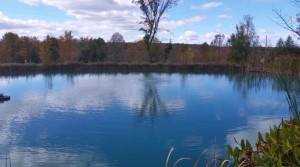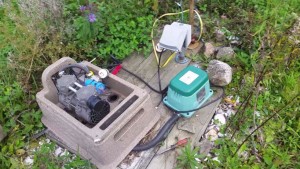The video below shows the difference of a rocking piston compressor and a linear diaphragm compressor. Both compressor output is over 4 cfm. The piston compressor is pushing 4.8 cfm and the linear at 4.2 cfm. Very similar output with very drastic effects of performance out in the pond at the diffuser boils.
The rocking piston compressor builds pressure to push the air deep into the pond. The deeper the water the more pressure the compressor has to overcome. Remember swimming to the deep end of a swimming pool and your ears pop? That is the water pressure that builds the deeper we go.
The rocking piston compressor, let’s call it mechanical, runs sort of like a car engine with a crankshaft, connecting rod(s) and piston(s) the electricity is the gas that spins the crankshaft which in turn makes the pistons move up and down, pulling air in and pushing it out to the diffusers. The limitation varies on compressor size but generally can push to the depths of 30 to 50 feet deep providing 30 psi or more depending on the compressor.
The diaphragm compressor is similar that in moves air but in a different way. There are two rubber discs on each end of a shaft. Around the shaft is a magnet, when electricity is applied the shaft moves back and forth, very fast, and with other rubber valves each movement intakes air and exhausts to the diffusers. The movement of the shaft is limited by the movement of the rubber discs. For example (these numbers are just for the example and do not represent actual sizes) we’ll say the movement is a half inch just sitting on the ground not hooked up to any tubing or diffuser. When we hook up to the diffusers at 4’ deep the movement of the shaft drops to 3/8 of an inch, going deeper to 6’ – 7’ we may only see a 1/8 of movement of the shaft. The less amount of movement back and forth provides less air moved and more pressure build up against the rubber discs.
The deeper the diffuser the more pressure is created by the water. This pressure is put back to the compressor making the shaft move less and less the deeper the diffuser is. Less movement means less air is being pumped and added stress on those rubber discs that will eventually fail.
As I got into this business I was led to believe the linear compressors would work up to 8’ deep. They actually do but have found you may be replacing the rubber discs every 6 months.
You can plainly see the difference from the piston compressor and diaphragm compressor in the video and the deepest depth was around 8 to 8 ½ feet deep. (the deeper the water the more water is moved and the larger the boil will be).The piston compressor had no problem of putting out 4.8 cfm to the diffusers while the linear at first didn’t even push air to the deepest diffuser until we worked the valves to push air to the deepest diffuser and once we did you see the boils are much smaller, which means less amount of water being moved as well. In our experience the linear compressors do work great and last a long time at 6′ of depth, pushing it would be 7′ and 8′ constant rebuild may be needed. At 9′ deep the compressor will be wore out with in 1-2 months.
Another item to look at with the linear diaphragm compressors is the tubing,. Typically when they are supplied as a kit with the diffusers, tubing, valves and compressors they need to be used and installed as per the instructions. If extra tubing is needed you’ll need to match the same size tubing that is supplied with the kit. Example of 1/2″ tubing that should be coming from the compressor and needing a few more feet to extend from the compressor should be 1/2″ If changing to 3/8″ tubing from the compressor to supply the 1/2″ tubing the flow will be restricted, creates back pressure and the compressor will fail prematurely.
The best way to know the depth of your pond is to get out here and measure it. Take a string and tie a weight to it and drop it in the pond. Pull up the string and measure from the weight to where the water line was.



